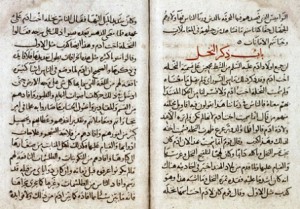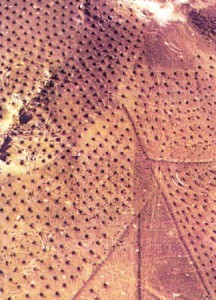You know how the internet is. Endless rabbit holes down which to lose oneself. Some questions answered. Others, not so much. New ones arise. Here’s an example. It all started with the Mosaic of the Seasons in the 5th century Byzantine church at Petra in Jordan. I visited the site last week and thought the agrobiodiversity-themed mosaics wonderful.

That got me thinking about Nabatean crops more generally. What did these people grow in the middle of the desert? Did it include the plants depicted in these mosaics? The Nabateans were known as spice (and incense) traders, but more as middlemen rather than actual producers. Why, indeed, did they find it necessary to grow anything at all in such a harsh environment? Couldn’t they have traded for everything they needed, sitting astride a major trade route from the East to Rome?
So I googled a bit, and it turns out there’s a book called Nabatean Agriculture. Or Al-Filahah al-Nabatiyah in fact, written by a 9th century Mesopotamian scholar called Ibn Wahshiyah. Unfortunately, though the Arabic text is online, I could not find anything that I could actually read on the contents of the book beyond that it includes “a wealth of knowledge on the preparation of basic foods from the agricultural products mentioned throughout the book.” Frustrating.

However, I did find an enormous amount on the sophisticated water management practices of the Nabateans, for example in the supporting document to Israel’s proposal for inscription of the “Desert Cities of the Negev” as a World Heritage Site. It’s a huge pdf, so watch out, but it does have great descriptions, starting on page 108, of the channels, damns and cisterns these communities built to save and manage water in a region with less that 100mm of annual rainfall. Some of these practices are in fact being revived. One consists of enigmatic piles of rocks called tuleilat el anab in Arabic, which means “grape mounds.” ((The photo is from that World Heritage Sites supporting document.))

They measure 1 m in diameter by 30 cm in height and in some places extend for several square kilometers. So it’s not just pleasure gardens we’re talking about. The prevailing view seems to be that the grape mounds were intended to enhance the flow of run-off water into agricultural terraces. Their name is the only clue to the crops grown by the Nabateans that I’ve been able to find ((Or does that refer to their appearance?)), apart maybe for those mosaics. There must surely be some archaeobotanical evidence somewhere? More rabbit holes beckon.
Hi Luigi
Those Nabataeans with their water harvesting systems, including microcatchment water harvesting, have been intriguing me for decades.
Check out scribd. It has one of Evenari’s papers.
ICARDA is really just reviving a well proven age old system of concentrating scarce rainfall to water a small area from a larger catchment. Good on them…
Neat. Came here by way of Scientiae Pro Publica. I like mosaics, too.
Hi if you visit the ancient city of Petra you will amazed with the water harvest system there.
I did. And I was.
I am an American living in Jordan and I’m also interested in this question. First, Jordan isn’t just a desert. In western Jordan the mountains recieve enough rain in the winter raining season for many plants and trees to grow, including olives, apples, grapes, figs, dates and wheat. Many plants such as succulents have adapted quite well to the long dry summer storing water inside there thick leaves. What isn’t eatable to us humans sheep and goat often find palatable. Secondly, the Nabateans made great use of this winter rain by collecting it in cisterns that they dug out of rock. Petra’s architecture is wonderful, but more intesting to me was their system of channels funneling water into underground cisterns.
True and Jordan is amazing I was born there and it is not a desert. I also went Petra and maybe if you had time you could have found info when you were inside Petra it would help you a lot but at least you tried plus you could have translated the Arabic to English. At least try a little harder but besides that you are awesome Luigi !!!!!!!!# awesome!!!!!!!!!!!!”
what did they eat?
The best english source on ibn Wahshiyyah’s al-filaha al-nabatiya is probably Jaako Hameen-Anttila’s “The Last Pagans of Iraq – Ibn Washiyya and his Nabatean Agriculture”, Brill, 2006
God bless ibn wahshiyya but he’s not talking about the nabaeteans at all. He’s actually writing about Babylonians possibly the Assyrians. According to him he found an ancient book in syriac and translated it. While also testing it. Great no nonsense guy for an alchemist. So his book is more useful as a list of what was grown in north arabia in the 10th century a huge number of plants btw